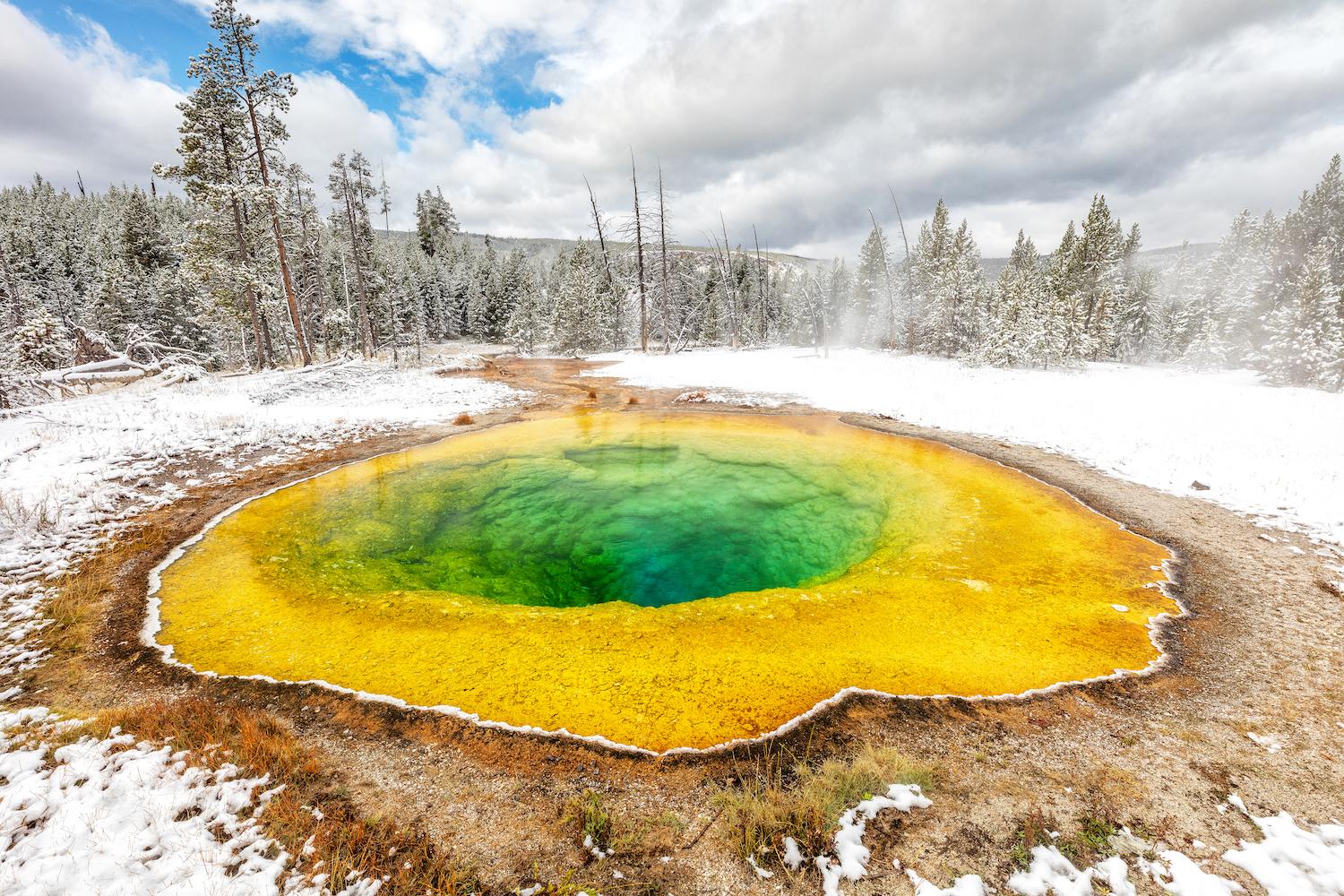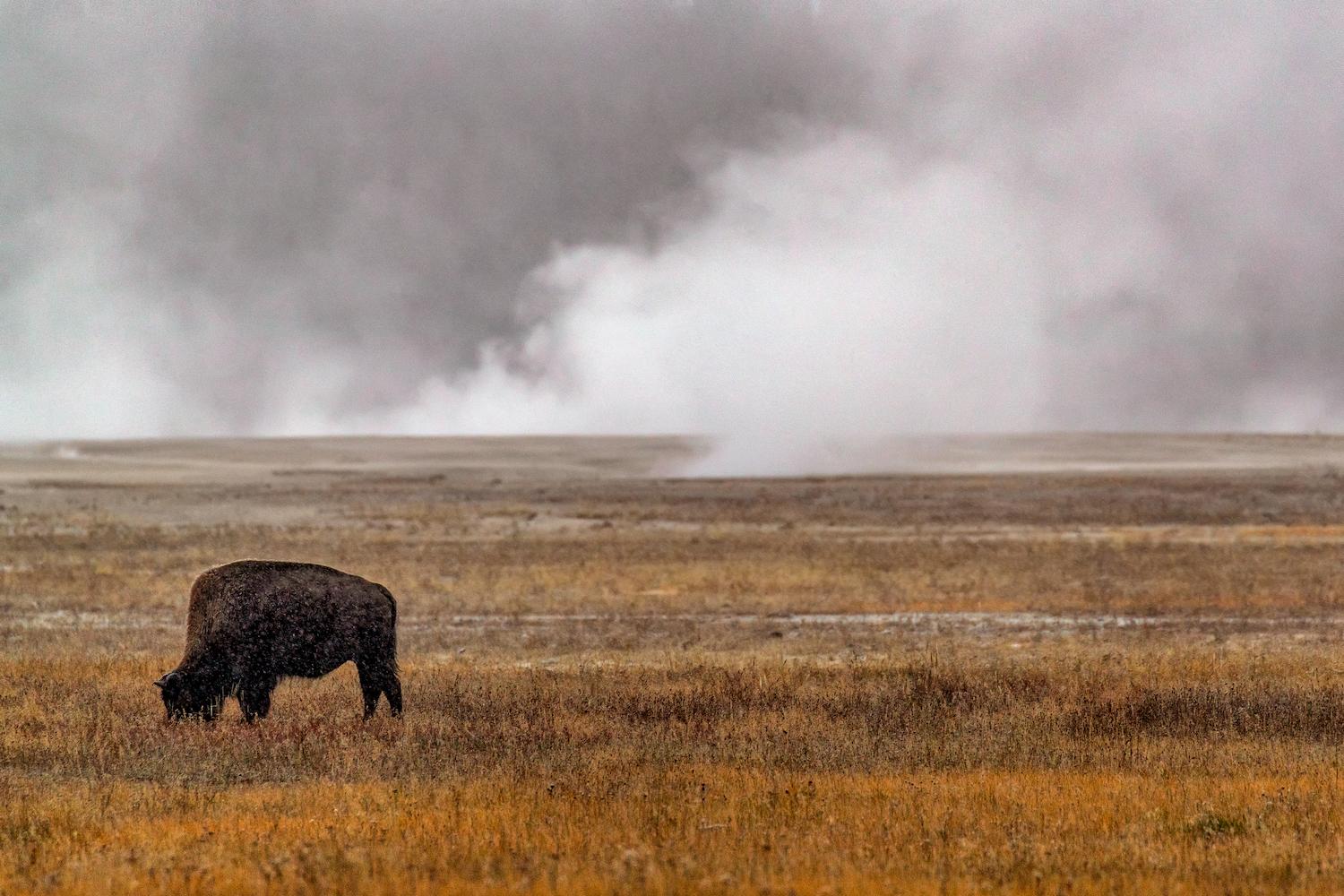
How will reduced snowfall in Yellowstone affect Morning Glory Pool and other thermal features in the park?/Rebecca Latson file
Report Predicts Drastic Change In Yellowstone National Park's Climate
By Kurt Repanshek
Unless climate change is abated, warmer temperatures, less snowpack and associated spring runoff, and a longer growing season by the end of the century will alter the appearance of Yellowstone National Park, according to a rigorous analysis of past, present, and predicted climate conditions for the Greater Yellowstone Area.
Those changes not only could affect the park's appearance, but likely alter how you experience the park. Though it predicted changes in the region's water regime, it was silent on how that could affect Yellowstone's world-famous geothermal displays. The anticipated changes also could impact wildlife interactions, as reduced snowpack could give prey such as elk and moose better traction to flee wolves. Without thick snowfields, any wolverines still in Yellowstone would head elsewhere, as they often search avalanche paths for carrion, and females den in snow caves.
Six years ago a special edition of Yellowstone Science, the park's science journal, made similar predictions. In that 2015 report the researchers found that some parts of Yellowstone had experienced 80-100 more days of above-freezing temperatures that they did in the mid-1980s. "In other words," they said, "the season during which temperatures are above freezing is roughly 3 months longer now than it was 25 years ago at the Northeast Entrance."
A year after that report, another said waning snowpack likely would affect winter recreation in the iconic park. Published in the journal PLOS ONE, it stated that varying snow conditions "that are likely to prevail across Yellowstone in the future may require a switch to conventional automobiles in some areas that are currently allocated for snowmobiles, such as the west entrance road, while in contrast, some areas such as the south entrance road are likely to be suitable for oversnow use until the end of the century."
Now the Greater Yellowstone Climate Assessment builds on those reports with analysis of trends in temperatures, snowfall, growing seasons, and precipitation cycles.
"This is the most comprehensive climate assessment conducted on the Greater Yellowstone Area. It does an excellent job of studying climate trends and impacts along with laying out scenarios for the future. Not surprising, those scenarios are not good," Yellowstone Superintendent Cam Sholly said Saturday. "This assessment will complement many of the efforts we’re making here in Yellowstone around translating climate data and science into specific actions to protect habitat and species."
The projections depicted in the report "push the bounds of historic trends," the superintendent wrote in a foreword to the more than 250-page report. As past studies have determined, the warming climate already has reduced snowpack depths at elevations between 5,000 feet and 7,000 feet, which in turn are increasing fire danger and leading to a die-off of iconic whitebark pines, which provide calorie-rich nuts for grizzly bears, squirrels, and jays. Bison are being impacted by changes to the park's grasslands, the report adds, and fisheries and songbird habitat also are being adversely affected.

Climate change likely will impact the park's wildlife in various ways/Rebecca Latson file
Changes in the climate affecting the Greater Yellowstone Area have been recorded in the past, the climate assessment noted.
"During the last glaciation, (22,000-13,000 years ago), the GYA was 5-7 degrees Fahrenheit colder than the pre-industrial period (1850-1900). The glacial period was terminated by a warming trend that led to rapid glacial recession and forest colonization," the report's authors noted. "By the early Holocene (11,500-7,000 years ago), the climate was up to 3.8 degrees Fahrenheit warmer than the pre-industrial period."
But those trends and the current situation and outlook had different drivers, they added.
"Past climate changes were caused by natural climate drivers (e.g., Milankovitch cycles, changes in atmospheric composition, volcanic activity, solar output, and atmosphere-ocean circulation," they said. "In addition to the consequences of natural drivers, the climate of recent decades has been warming as a result of human-caused emissions and attendant increases in GHGs (greenhouse gases). Based on weather station data, the GYA has warmed on average by 2.3 degrees Fahrenheit since 1950. This warming has resulted in a growing season that now is two weeks longer than it was in the 1950s, and below 8,000 feet annual snowfall has declined by 25 percent (nearly 24 inches), including by 96 percent in September. The rapid warming that marks the end of winter now occurs in February to March, instead of March to April as it did in 1950."
(Milankovitch cycles describe the collective effects of changes in the Earth's movements on its climate over thousands of years--Wikipedia.)
Although rainfall is expected to increase, the loss of snowfall and snowpack are concerning, as they dictate the annual water cycle for the region, the report stressed.
"... drought is a recurring hydrologic feature of the GYA. Like much of the Western United States, with future warming drought in the GYA will likely become more frequent and severe," the report stated. "Predicting hydrologic drought and seasonal availability of water in snow-dominated areas will become increasingly more challenging as less precipitation falls as snow, snowpack declines, and evapotranspiration increases."
Despite confidence expressed in the projections, the authors also made a list of issues that needed continued study to more clearly identify the impacts anticipated to occur through climate change. Among them:
- There needs to be expanded monitoring of fish and wildlife to improve understanding of their changing behavior, disease, and distribution in response to climate change.
- Develop and apply more detailed models of snow processes, groundwater, surface water, and ecosystem and human water demand to refine the understanding of water and water use in the GYA.
- Maintain and expand monitoring of snow, streams, lakes, and wetlands within GYA watersheds. Currently, weather stations and streamgages are unevenly distributed in the GYA, few water bodies and wetlands are monitored, particularly at high elevations, and water demand for ecosystems and for human use and consumption is poorly measured.
- Continue to improve understanding of the linkages between long-term trends in fire climate and short-term fire weather and fuel conditions so that we can better project fire activity.
- Support studies of forest health, including the impact of climate change on insect outbreaks, wildfire activity, drought-caused mortality, and carbon storage to guide appropriate management planning.
- Quantify how climate change in the GYA will affect vital ecosystem services, including air quality, water quality and quantity, food, timber, and biodiversity.
The researchers who put the report together conducted a number of interviews with GYA stakeholders. Among the key concerns they raised were the future prospects for water availability and habitat for wildlife and recreational pursuits.
"Many participants were concerned about the impact of climate change on the region’s communities. Specific concerns included increased wildfire risk, threats to infrastructure, and unsustainable water usage," the researchers wrote. "Concerns about the health of fish and wildlife were also expressed, including climate-triggered fish kills and wildlife population declines. Local Government/Utility and Agriculture participants were most concerned about the effects of climate change on communities, while Conservation and Agency groups more often mentioned threats to fish and wildlife. Tribal and Recreation participants were equally concerned about both topics."
The report's findings are not startlingly new, but just the most recent iteration of concerns that have been expressed over the last decade, at least. Back in 2011 the Interior Department outlined a program to address climate change on public lands. One aspect of that plan was to create regional "climate science centers" "to provide climate change impact data and analysis geared to the needs of fish and wildlife managers as they develop adaptation strategies in response to climate change."
A 2018 study said the landscapes preserved by the National Park System are bearing a disportionately greater impact of climate change than the rest of the United States. And a 2013 video warned of the changes climate change could bring to the Greater Yellowstone Ecosystem.
"Climate change impacts are not just environmental. Every year, millions of visitors from across the world come to Yellowstone to see the park’s awe-inspiring landscapes and wildlife and spend hundreds of millions in local economies. The communities within the GYA are experiencing rapid growth as people move to the region to enjoy the amenities. Climate impacts throughout the GYA, if not addressed, will directly affect the strength of local and regional economies as resource values and use change across the region," Sholly noted in his foreword to the report. "The Assessment makes clear that the scale of climate change impacts far exceeds the ability of any one park, agency, organization, or community to effectively respond as a single entity. Integrated, cooperative adaptation strategies across large geographic areas will lead to more informed, comprehensive, and successful results."
Support National Parks Traveler
National Parks Traveler is a small, editorially independent 501(c)(3) nonprofit media organization. The Traveler is not part of the federal government nor a corporate subsidiary. Your support helps ensure the Traveler's news and feature coverage of national parks and protected areas endures.
EIN: 26-2378789
A copy of National Parks Traveler's financial statements may be obtained by sending a stamped, self-addressed envelope to: National Parks Traveler, P.O. Box 980452, Park City, Utah 84098. National Parks Traveler was formed in the state of Utah for the purpose of informing and educating about national parks and protected areas.
Residents of the following states may obtain a copy of our financial and additional information as stated below:
- Florida: A COPY OF THE OFFICIAL REGISTRATION AND FINANCIAL INFORMATION FOR NATIONAL PARKS TRAVELER, (REGISTRATION NO. CH 51659), MAY BE OBTAINED FROM THE DIVISION OF CONSUMER SERVICES BY CALLING 800-435-7352 OR VISITING THEIR WEBSITE WWW.FRESHFROMFLORIDA.COM. REGISTRATION DOES NOT IMPLY ENDORSEMENT, APPROVAL, OR RECOMMENDATION BY THE STATE.
- Georgia: A full and fair description of the programs and financial statement summary of National Parks Traveler is available upon request at the office and phone number indicated above.
- Maryland: Documents and information submitted under the Maryland Solicitations Act are also available, for the cost of postage and copies, from the Secretary of State, State House, Annapolis, MD 21401 (410-974-5534).
- North Carolina: Financial information about this organization and a copy of its license are available from the State Solicitation Licensing Branch at 888-830-4989 or 919-807-2214. The license is not an endorsement by the State.
- Pennsylvania: The official registration and financial information of National Parks Traveler may be obtained from the Pennsylvania Department of State by calling 800-732-0999. Registration does not imply endorsement.
- Virginia: Financial statements are available from the Virginia Department of Agriculture and Consumer Services, 102 Governor Street, Richmond, Virginia 23219.
- Washington: National Parks Traveler is registered with Washington State’s Charities Program as required by law and additional information is available by calling 800-332-4483 or visiting www.sos.wa.gov/charities, or on file at Charities Division, Office of the Secretary of State, State of Washington, Olympia, WA 98504.

Comments
It is very distressing to see how low water levels are. I live in southern Alabama and get lots of rain. I had a sprinkler system installed at my house and everybody told me how nice my lawn looked. A few years later we were in a period of drought, I turned it off and haven't used it since. I'd rather have water for drinking and bathing than a green lawn. Doing this made me look at other ways I could lower my water usage and have made other changes to use less water. I wonder how much water would be conserved if people in Nevada, New Mexico, California, Arizona, etc., didn't try to make their yards look like those in Maine? Just saying. . .
80% + of the water in those states is used for agriculture. The amount used for irrigating lawns is pretty small.
This is incredible and also terrifying.